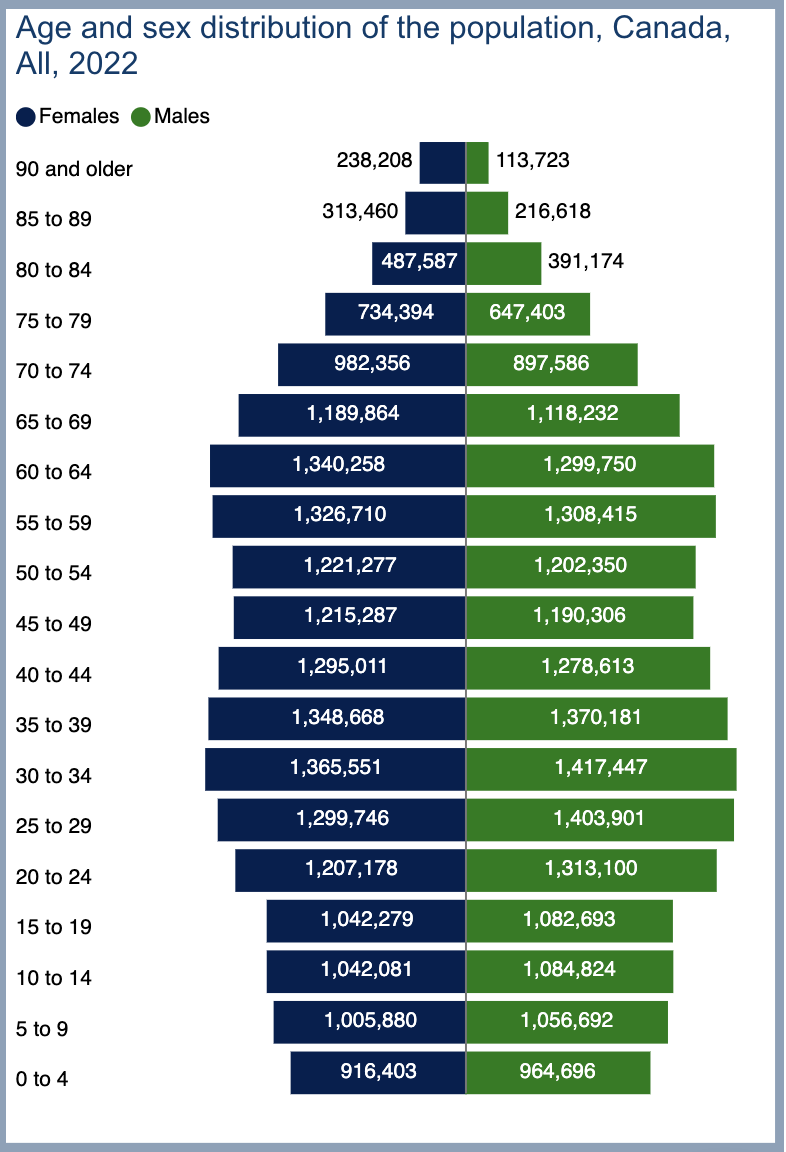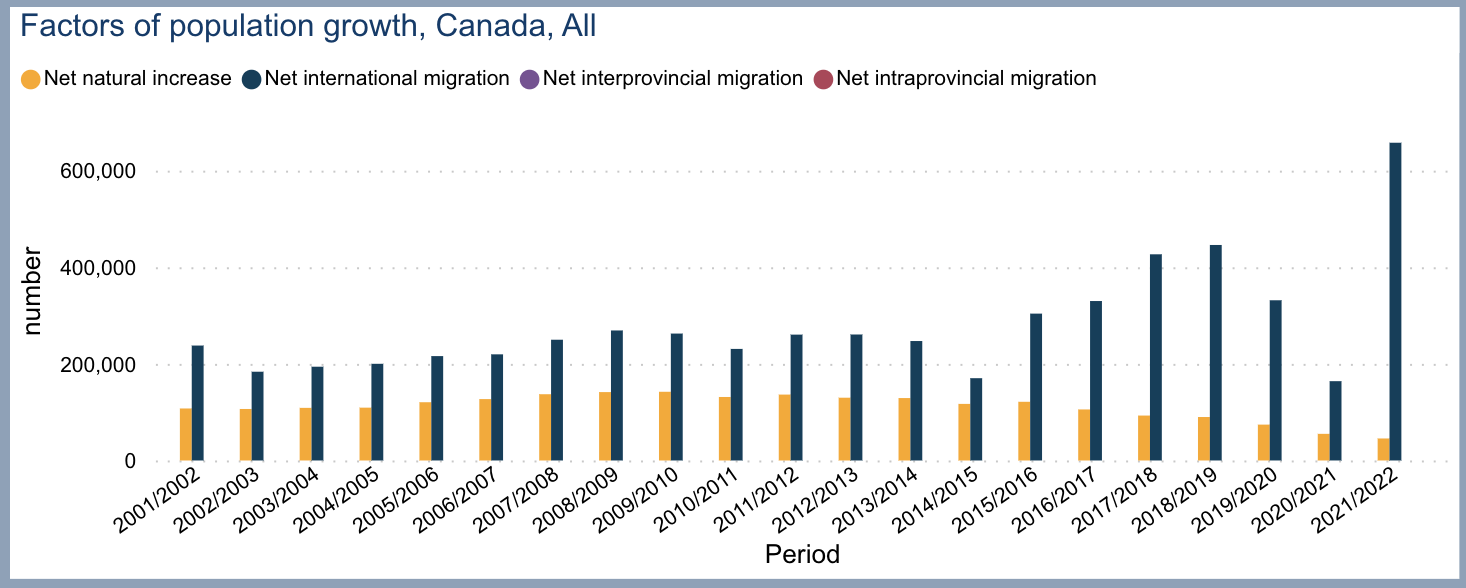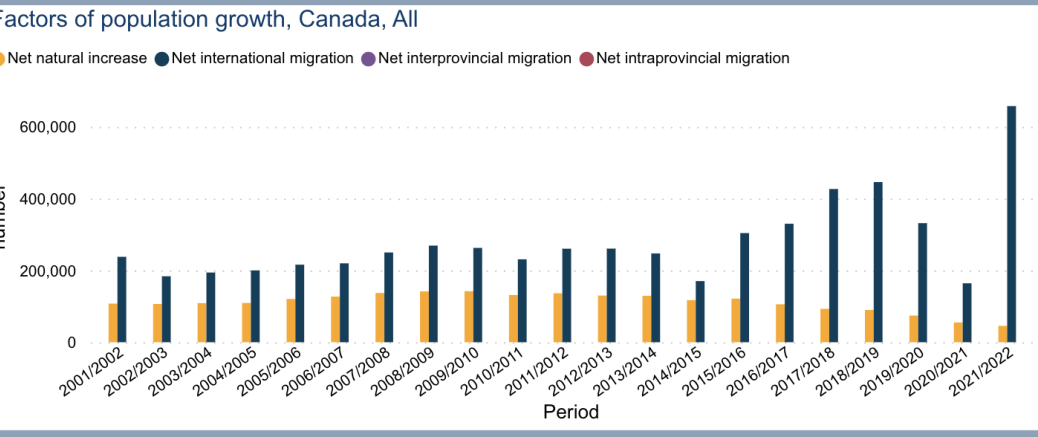Demographic hollowing out is like a cobra: fascinating and deadly. This topic will shape our world of the next 100 years in profound ways, yet receives very little public attention.
The Canadian Situation
The Canadian demographic situation is very similar to other countries, having seen a declining birth rate for many decades. As of 2022, the distribution by age in 5 years blocks shows a healthy triangle at the top (ages 60 and older). Below that point, however, the pyramid inverts. 1

The Baby Boomer generation, currently retiring, was born after WWII and when they had kids, there was an "echo generation", a second smaller bulge which we know as the Millennials. The Millennials didn't have many kids for several reasons. This sped up the pyramid's inversion.
The speed of the inversion increases as it progresses, since the below replacement birth rate applies to fewer and fewer people. This is compounding, but in reverse. With compounding, nothing seems to happen for a long time and suddenly everything happens at once.
As of July 1, 2022, Canada's population had increased again to 38.9 million. 2 So, with declining birth rates, how does Canada's population continue to grow?
Two factors stick out and immigration most obviously. The immigration numbers on the chart below started rising sharply in 2016 as the Liberal government took immediate steps to address the demographic problem looming on the horizon. Should Conservatives make up the next government, don't expect their immigration policies to change much. The writing is on the wall: Canada needs immigrants to continue to survive.

The second factor in Canada's population growth is people living longer. The pyramid at the top, in previous generations, was shorter (few people lived to be 90 and older) and narrower (fewer people in each successive age grouping). An important factor of early population growth was the decrease in child mortality, which really led to a population explosion. As those surviving children age, they also live much longer than ever before.
The coming "bomb" describes the opposite: the elderly pass out of the world with very few young people to replace them. This creates an obvious a societal problem and a less obvious economic one centred around the triple poles of creation, consumption and savings.
In simple terms, the economy is some people making things, other people buying those things, and everyone having enough capital. Technically, we term making things "manufacturing", though it extends to making services, as well. Economists call buying things "consumption". What has oiled the wheels of manufacturing and consumption has been borrowing, which has received huge influxes of cash from the baby boomers saving for their retirement.
From the perspective of the average investor, mutual funds don't seem like debt, but that is how companies see them: an infusion of cash which they must someday repay with interest. Companies have several options to raise capital for their projects and stocks is just one possibility with its own set of pros and cons. Wise managers balance the advantages against the disadvantages when choosing how to finance their business. Stocks have been attractive for decades because investors were mostly looking for long-term appreciation rather than short-term gains.
The massive cohort now entering retirement will draw capital out of the economy for living expenses. The huge group of retirees, accustomed to high standards of living, will withdraw an enormous amount of capital rapidly. The cheap capital driving our world's abundance will dry up. Furthermore, we don't have enough young people saving enough money to replace the withdrawn savings.
Unfortunately, it gets worse. Middle-aged workers are, globally, the most skilled and hard working cohort. In Canada, they are a substantial portion of the population. As they leave the marketplace, we don't have nearly enough young people to fill in the gaps.
Automation in every economic area transforms from a nice-to-have into a necessity to keep Canadian living standards high. Increasing worker productivity 2 or 3 times is one of the only ways to avoid the coming economic crash and pain. Demographically speaking, we have a very short timeframe in which to make this change.
All of this means that the standard of living Canadians have become accustomed to appears set to drop dramatically in the coming 20 years.
Whether English or French, Caucasian Canadians have been the majority population for a long time, while the aboriginal population reports feeling like outsiders in their country. Since immigration no longer comes from European countries, the demographics of Canada will transform. With a million or more immigrants a year coupled with the Baby Boomers leaving the world, Caucasian Canadians may also soon feel like outsiders in their country.
Enter the Dragon
Canada is not the only area facing demographic collapse, nor is it the most threatened. Asia has some of the highest costs of living on the planet. Japan, Korea and Asia all point to these high costs as the reason for incredibly rapid declining birth rates. As the most recent and rapid industrialized countries, they are also a unique case study for collapse because their populations are shrinking faster than most other regions. For example, in 2023, Korea announced its birth rate fell to 0.7%, shockingly far below the "replacement rate" usually quoted as 1.1 children per woman.
Japan has recognized the coming "age wave" (the Boomers going into retirement) for decades. When I left the country in 2003, even morning TV shows openly discussed it. Self-aware enough to realize their society is more insular than Western countries, they knew that immigration could never solve the problem for them.
They poured early efforts into educating the public about the consequences, alternatives, and costs. Then they poured large amounts into policies encouraging young people to have kids. At the opening of the January 2023 diet, Prime Minister Kishida 3 again suggested that the nation's falling birthrate represents an existential threat to Japanese society. The 2022 birthrate was below 800K, compared to 2.09 million in 1973 (Japan's baby boom peak).
Policies for Making Babies Boom
In his discussion on the declining population of Chinese young people, Liang4 suggests China's cost of raising children is one of the highest in the world. He compares Scandinavia, where the cost of raising a child is between two and three times per capita GDP to to China, where it is 6 to 7 times per capita GDP. He claims the total cost of raising a child is ~$69k USD.
Liang points to these costs as the primary reason for the declining birth rate, and other country's analysis are similar. If the problem actually lies in the cost of living, the solution seems equally straightforward: reduce the costs parents bear to have children.
Over several decades, the Japanese government attempted to spark a baby boom with cash and other incentives without much success. Parents receive ¥15,000 (~\(150 CAD) per child per month until they reach age 3 followed by a ¥10,000 (~\)100 CAD) monthly allowance until graduation from junior high school. The ruling party wanted to increase those numbers as further incentive.
Such policies, historically, however have had little influence on birthrates. So, hearing a Chinese analyst suggesting to solve the problem with policy changes, which mostly reduce to offsetting cost of living in urban centres, I can't help but think they might be chasing a failed approach.
The Entrepreneurial Connection
It is no coincidence that Liang, an entrepreneur, advocates for increasing the number of young people in society. He observes entrepreneurs and young people being two groups strongly affected by the inverted population pyramid. It's easy to see why.
Young people have been our economic cannon fodder as long as humanity remembers. Lots of kids for hunter gatherers and agricultural societies worked out as free labour. In modern industrialized societies, where children rarely do the same things as their parents, and thus provide few economic inputs and many economic outputs, the calculus is different. This reliably leads to fewer children in every industrialized country.
But youth still serve important functions in society. As we look back at the sources of innovation, youth are obviously a vital driver of new ideas. Youth, still finding their place in the world usually have fluid boundaries and greater openness. Young people have not yet become locked into large investments (cars, houses, children, etc.) making them more flexible and willing to take on risk. They are also the ones most likely to attempt entrepreneurial innovation. Taking on the risk of a speculative venture is easier when time and energy to recover from setbacks are plentiful.
It is possible that in our approaching future elderly people, at least those with the most financial security (e.g. pension and other safety nets), could produce a burst of entrepreneurial activity. I wouldn't hold by breath, though. Such a shift in activity would require a massive reworking of retired people's worldview precisely when most people feel increasingly resistant to change. Retirement, as a concept, rests on an attitudinal pillar of, "I've worked hard; I deserve to rest". The socio-economic forces required to dissolve that pillar are frightening to consider.
Don't Leave it to Chance
One radical approach sees governments and private citizens take the problem into their own hands. If youth and entrepreneurs face the largest disadvantages of a population collapse, they also receive the most benefits from solving the problem. These groups look for a technical solution naturally. Governments, seeing the decline in revenue from decreased business and employment productivity, might also become inspired to change the direction of societal evolution.
The technical solution, artificial wombs (technically known as "ectogenesis"), has existed for a couple of decades now and is improving quickly. Positioned between in vitro fertilization and premature infant care, scientists aim to create artificial wombs to improve life outcomes for babies who leave the womb too soon. Ectogenesis has developed into its own study.
Israel, Japan and some European countries currently lead the field. An Israeli biotech firm can even start with blood or skin cells to create a mouse embryo, growing it to the human equivalent of 50 days old. 5 Fifty days is an important stopping point because of ethical and regulatory guidelines which currently govern the field. Another set of regulations and ethical boundaries which direct such medical research restrain researchers from keeping an embryo longer than 40 weeks. Society still finds cloning objectionable because of the risks of abuse, a topic widely explored in popular literature and films.
Entrepreneurial Grandparents
Why couldn't a generation already practiced at child rearing raise the next generation? Retirees entering their "golden years" may never choose to build new companies, but they could choose to raise a new generation of children. While fertility is problematic, ectogenesis obviates the issue. Nor is it necessary to clone people, as there is an enormous untapped source of infants already available.
In the US alone, approximately 1 million abortions take place annually. The issue is fraught and I'm not interested in arguing for either side, but only bring it up to note a single point of agreement between the sides. Moral conservatives on both sides of the issue agree the practice weighs the mother's life against the child's in a zero-sum competition. Ectogenesis could theoretically change the calculus, allowing both to live. By moving the fetus into an artificial womb, it can safely gestate to maturity. The mother can then receive whatever life-saving treatment she needs that would have jeopardized the infant.
The government could, with a little effort, broker agreements between retirees and women seeking abortions. The nature of democratic governments makes this unlikely, as they are far more likely to be strongly reactive instead of forward looking. Governments also stick with the status quo, improving re-election prospects.
For these reasons, I think private companies will probably develop to fill the gap, providing life-saving services to women and children alike, while also serving society with a source of new children.
Naturally, there are advantages and drawbacks to having a child later in life. The financial and emotional stability of older people often makes them terrific parents. They are less likely to perpetrate abuse, which too often springs from the pressures young people feel coupled with chemical processes amplifying the experiences of those pressures. Conversely, older parents grow increasingly conservative and don't have the energy to keep up with kids, leading to children who can act more like old people than young thrill and risk seekers. Whether this is good or bad depends on perspective.
Concluding thoughts
This short essay on such a complex and emotional topic only scratches the surface. So, let me conclude with just one non-obvious benefit of multi-generational interactions. There is interesting research showing how older people's health and cognition improve with regular exposure to young people. Similarly, young people exposed to their elders people are more stable emotionally and mentally. The complex benefits for both parties are missing from single- or double-generation households.
-
Most of the statics and charts in this article derive from a Statistics Canada's 2022 dashboard.
Statistics Canada. (2022). Annual demographic estimates, rural and urban areas: Interactive dashboard. https://www150.statcan.gc.ca/n1/pub/71-607-x/71-607-x2021030-eng.htm ↩ -
Statistics Canada. (2022). Demographic estimates by age and sex, provinces and territories. https://www150.statcan.gc.ca/n1/pub/71-607-x/71-607-x2020018-eng.htm ↩
-
Takahara, K. (2023, January 23). In policy speech, Kishida puts focus on child care and defense. The Japan Times. https://www.japantimes.co.jp/news/2023/01/23/national/politics-diplomacy/kishida-policy-speech-child-care-defense/ ↩
-
Liang, J. (2023, July). Liang Jianzhang on China’s Looming Demographic Disaster. Reading the China Dream. https://www.readingthechinadream.com/liang-jianzhang-on-chinas-looming-demographic-disaster.html ↩
-
Ashok, L. (2022, September 26). Israeli Biotech Startup Renewal Bio Creates Synthetic Embryo. StartuptoEnterprise. https://startuptoenterprise.com/technology-news/israeli-biotech-startup-renewal-bio-creates-synthetic-embryo ↩
